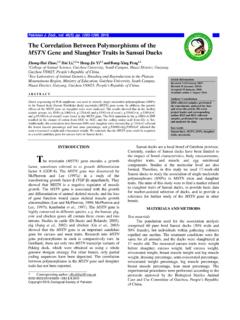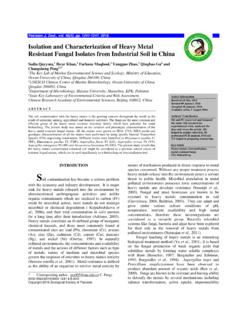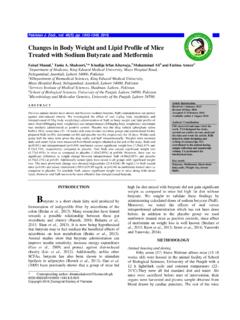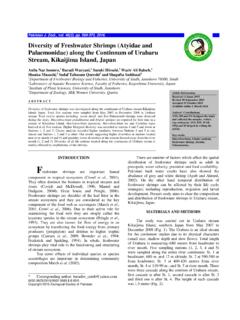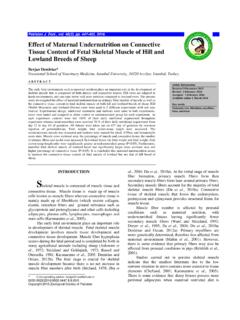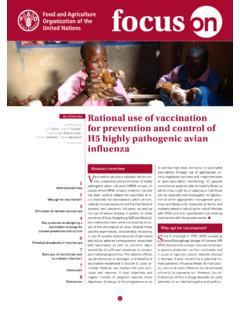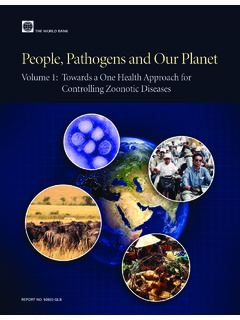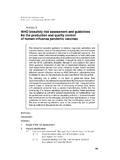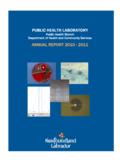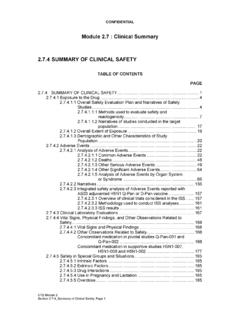Transcription of Comparative Antiviral Efficacy of Zanamivir and …
1 Article Information Received 20 April 2015 Revised 29 December 2015 Accepted 17 March 2016 Available online 1 August 2016 Authors Contributions SU performed virus genome sequencing. MAAS performed virus isolation in eggs. AUK prepared virus inoculum. QUN performed haemaglutination inhibition assay and isolated the virus. MIK and MY maintained and monitored the experimental birds. MY performed necropsy of turkey and scoring of clinical lesion. SU and MAAS analyzed the data. SU and MY wrote the article. Key words Zanamivir , Amantadine, Efficacy , avian influenza virus (H9N2). Pakistan J. Zool., vol. 48(5), pp. 1443-1447, 2016. Comparative Antiviral Efficacy of Zanamivir and Amantadine Against Tunisian Isolate of avian influenza Virus (H9N2) Sajid Umar,1,4* Muhammad Irfan Khan,2 Muhammad Younus,2 Qamar-un-Nisa,3 Aman Ullah Khan,2 Muhammad Yaqoob1 and Muhammad Ali Abdullah Shah1 1 Pir Mehr Ali Shah Arid Agriculture University, Rawalpindi, Pakistan 2 College of Veterinary and Animal Sciences, Jhang Campus, Pakistan 3 University of Veterinary and Animals Sciences, Lahore, Pakistan 4 National Veterinary School, Toulouse, France A B S T R A C T New emerging avian influenza A viruses pose a continued threat, not only to avian species but also to the humans.
2 avian influenza viruses increasingly crossing species barriers possibly with increased zoonotic potential. Due to rapid spread of influenza viruses, zoo animals and birds are at great risk. There are many species in zoos that are part of worldwide programme to save endangered species. Vaccination may protect birds kept in zoo against avian influenza as preventive and eradication programme along with culling and biosecurity. However, to eradicate influenza infection from valuable bird species in zoos, novel strategies are needed, including Antiviral treatments. Antiviral treatments of infected birds kept in zoos are appropriate to prevent death of those birds that are part of genetics pool. The present study evaluated the anti- influenza Efficacy of the potent neuraminidase inhibitor Zanamivir and ion channel blockers amantadine in avian species using chickens.
3 Zanamivir showed high Antiviral Efficacy than amantadine in the chicken model. Sequence analysis revealed mutation in matrix (M2) gene of virus for reduction in Antiviral Efficacy of amantadine. Anti- influenza drug administration combined with active surveillance and vaccination strategies could be useful for control of AIV in precious captive birds. INTRODUCTION avian influenza (AI) is a respiratory disease. Its causative agent influenza A viruses are prevalent worldwide and classified as either highly pathogenic AI (HPAIV), causing severe systemic disease with high mortality, or low pathogenic AI (LPAIV) inducing relatively mild clinical signs in birds (Alexander, 2007;Subtain et al.,2011; Umar et al., 2016). Highly pathogenic avian influenza (HPAI) is one of the most devastating viral diseases in bird species; it exacts high mortality in poultry and, increasingly, is a potential source of widespread and grave infections of mammals, including humans.
4 Since 1997, H5N1 HPAI has caused over 500 human infections with approximately 60% mortality (WHO, 2010). Furthermore, avian influenza virus (AIV) is known to have a propensity for interspecies transmission and potential for pandemicity (Baigent and McCauley, 2003; Morens and Taubenberger, 2010). For example, during the HPAI H5N1 virus outbreak in Thailand In December 2003, two _____ * Corresponding author: 0030-9923/2016/0005-1443 $ Copyright 2016 Zoological Society of Pakistan tigers (Panthera tigris) and two leopards leopards (Panthera pardus) at a zoo in Thailand died unexpectedly, highlighting the interspecies transmission ability of AIV (Keawcharoen et al., 2004; Quirk, 2004). In addition, there is evidence that the transmission of low pathogenic avian influenza (LPAI) virus from avian to mammalian hosts continues to occur, perhaps preluding the emergence of a new pandemic virus (Butt et al.)
5 , 2005; Cui et al., 2014). LPAI H9N2 virus can pose a significant zoonotic threat like H5N1 (Ahad et al., 2013; Umar et al., 2015a). Monitoring AI viral infections in domestic and wild birds is therefore important to control animal diseases and prevent humanpandemics (Zhang et al., 2009; Tombari et al., 2013). Through the acquisition of gene segments from other viruses H9N2 has under gone evolution to a more diverse genotype in terrestrial poultry birds since the early 1990. Genome study of recently isolated H9N2 viruses has shown extensive genetic re-assortment of these viruses with highly pathogenic avian influenza (HPAI) viruses (Tombari et al., 2011; Iqbal et al., 2009).To control influenza infection, a variety of vaccines and Antiviral drugs have been developed for administration to humans and animals (Boltz et al.
6 , 2010; Salomon and Webster, 2009; Sambhara and Poland, 2010). In avian species, AIV S. UMAR ET AL. 1444vaccination is generally not allowed in many countries. However, based on a desire to protect genetically unique birds, Europe and Singapore granted permission for an emergency AIV vaccination, allowing zoos to vaccinate valuable stock with an inactivated vaccine (Philippa et al., 2007; Elahi et al., 2015). Although vaccination of exotic and zoo birds for the prevention of AIV infection has been suggested (Bertelsen et al., 2007; Furger et al., 2008; Koch et al., 2009; Lecu et al., 2009; Philippa et al., 2007), a significant species variation in serologic response was reported in previous vaccine studies using zoo birds (Bertelsen et al., 2007). Furthermore, the lag time between identification of a newly emerging strain and vaccine development/ distribution, and concerns regarding vaccine Efficacy and safety are problematic (Boltz et al.
7 , 2010). The use of neuraminidase inhibitors in humans was very effective during the initial phases of the 2009 H1N1 pandemic when vaccines were not available (Boltz et al., 2010). However, in animals, vaccines are only considered with a comprehensive program including biosecurity, culling, diagnostics, and surveillance to control and eradicate AIV (Kapczynski and Swayne, 2009). Therefore, novel strategies such as Antiviral treatment are needed for the protection of valuable zoo birds from AI infection. In a previous study, in ovo studies demonstrated that the neuraminidase inhibitor Zanamivir is nontoxic for chicken embryos and prevents entirely the replication of a HPAI of the subtype H7N1 (Kaleta et al., 2007; Shaukat et al., 2011). However, in avian species, the Antiviral Efficacy of neuraminidase inhibitors and protein clockers has not yet been evaluated for clinical applications.
8 The present study evaluated the anti- influenza activity of the potent neuraminidaseinhibitors ( Zanamivir ) and viral matrix protein (M2) inhibitor (amantadine) in chicken. This report is the first study conducted on the Efficacy of Antiviral drugs against circulating LPAI (H9N2) virus in chickens in Tunisia. MATERIALS AND METHODS Virus inoculum stocks Experimental study protocol was approved by the Animal care and research committee of the Pir Mehr Ali Shah Arid Agriculture University Rawalpindi and experimentation were carried out according to the guidelines of committee. avian influenza A virus, (A/ chicken/Tunisia/12/2010 (H9N2) was a field isolate obtained National Veterinary School Tunisia. Viral stocks were prepared and titrated in 9 to 10-day-old chicken embryonated eggs.)
9 Median embryo infectious dose (EID50) was calculated using previously reported methods (Reed and Muench, 1938). The viral stocks were diluted in medium containing antimicrobials to yield a final titre of 106 EID50 ml. Animals Forty 3 weeks-old broiler chickens (Gallus gallus) were purchased from local hatchery and used in the experiment. All birds were declared serologically na ve and free from influenza viruses before the start of the experiment using haemagglutination inhibition and virus isolation (Iqbal et al., 2013; Umar et al., 2015b). Drug administration Zanamivir (Relenza GalxosmithKline) and amantadine (Symmetrel Endo Pharmaceuticals) were separately mixed 1:1 with phosphate buffered saline (PBS) and administered orally. Zanamivir and amantadine treatment ( mg/kg of body weight/twice a day (1mg/kg of body weight/day) for 5 days began 4 hr before virus inoculation.)
10 Control inoculated chickens received sterile PBS on the same schedule (Lee et al., 2011). Experimental design Each group of experimental birds was kept in cages in separate rooms. General animal care, water and standard poultry feed ration were provided throughout the experiment by animal house staff according to the requirement of birds. The birds were divided randomly into 4 groups; Zanamivir treated group, amantadine treated group, PBS treated mock infected control group and PBS treated non infected control group. Each group (n =10) were housed in separate animal isolators. The birds of the drug-treated groups ( Zanamivir & amantadine) and the PBS treated group were infected intranasally with a titer of 106 EID50/bird (50% egg infective dose /bird). The chickens were sacrificed at day 5 post-infection for virus isolation and titration.

